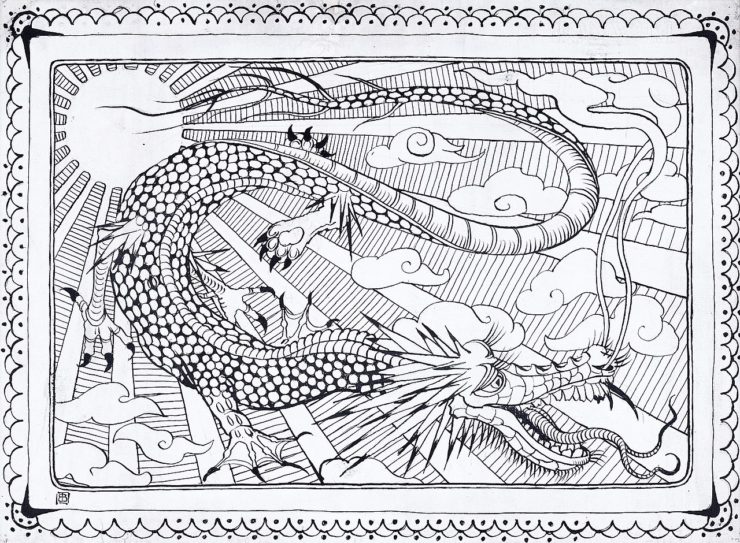Dragons are cool. Giant scaly (or feathered) winged beasties, hovering in the skies or lurking in deep, dark caverns. Some are bearers of luck, some wreak havoc with a belly filled with fire. And many seem to be really into sitting around on a giant gold pile (though why is murky—are they hoping to bring back the gold standard?). So, yeah, dragons in fantasy literature are the coolest creatures out there (yes, I know, they can also be extremely hot), and their presence lends a grandeur and majesty to any story. Depending on the story, they may be metaphor for the human condition, they may be aliens we live among, or they may be an existential threat unlike any you’ve ever encountered before.
…Except that not all dragons are like that. In fact, some of the most memorable creatures in fiction stick with us because they are the exact opposite of all of those things we’ve come to expect. So I’ve dug into the hoard—shh, don’t tell them!—and come up with some real gems from across fantasy literature…here are my favorite offbeat, eccentric, and reluctant dragons of unusual ability (and sometimes size).
Errol (Guards! Guards! by Terry Pratchett)
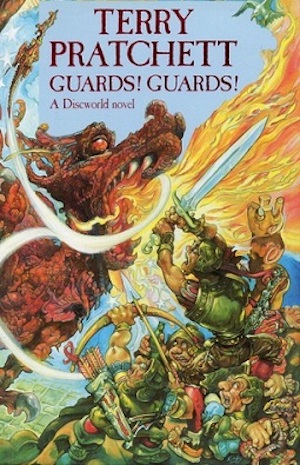
Officially known as Goodboy Bindle Featherstone of Quirm, Nobby nicknamed this swamp dragon Errol and it just kind of stuck. At first, he doesn’t seem like much of a dragon of any sort—swamp or otherwise. Lady Sybil, founder of the Sunshine Sanctuary for Sick Dragons, keeps him as a pet. His face is long and thin, he’s got a lumpy body and enormous nostrils. He doesn’t seem able to make fire or even fly (he’s got wings that are almost as big as his eyebrows).
But Errol turns out to be a dark horse—er, dragon—in the end. When Ankh-Morpork becomes the target of a Noble dragon, Errol springs into action and startles everyone by being, well, a particularly great dragon! Not only can he produce flame (backwards, but still) and sonic booms, but he re-arranges his digestive system to become a supersonic jet engine! After all, the only thing better than a dragon is an unexpectedly competent dragon.
Gork (Gork, the Teenage Dragon by Gabe Hudson)
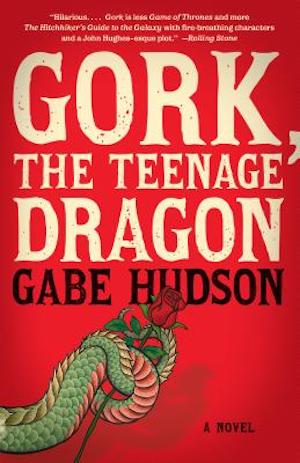
Being a teenage dragon is about what you might expect, even if you only have experience with teenage humans. Gork cares about some things, but he doesn’t care about all of the things he’s supposed to care about as graduation from WarWings Military Academy approaches—namely, convincing a female dragon to agree to be his queen. All he has to do is accomplish that one mission, and then they can go off to a distant world and conquer it together. But if his female dragon of choice turns him down, Gork becomes a slave.
That’s quite a lot to ask from a not-yet-mature dragon who suffers with an oversized heart, with horns that are only two inches long, and who sometimes just… faints. Besides, he’s got his beady eyes set on his one true love already: Runcita Floop, the dean’s daughter—and the dean has no intention of letting Gork pledge his troth. All that aside, Gork also has to battle bullies and a grandfather named Dr. Terrible whose intentions are muddy to say the least. At least he’s got his pal Fribby and a sentient spaceship to help guide him around. Will he succeed? Probably, but not in the way any of us expect.
Ember (Talon by Julie Kagawa)
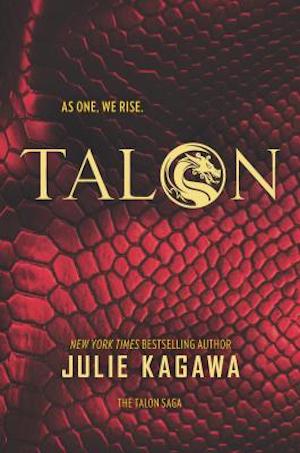
Oh, to be young and in love with a forbidden suitor who kills dragons! But it’s this last bit that’s problematic for 16-year-old Ember (who has a twin, Dante) because, well…she’s a dragon. A premise that could have been farcical is instead the basis for a heartfelt paranormal romance because in this world, dragons are often shape-shifters who look pretty much like the humans sent to wipe them off the face of the earth. As a young dragon, Ember has to convince everyone she can blend in with human society—but then she meets a fellow rogue dragon named Riley and a soldier named Garret who’s part of a dragon-slaying order, and develops a connection with both of them.
Hey, we get it: teen hormones always supersede reason, sense, and the fact that the people you’re mixed up with have been murdering your kin. But Garret is more than the sum of his beliefs, and after watching Ember in action his eyes open to a whole new world. Who says dragons can’t be romantic?
Drogon, Rhaegal, & Viserion (A Song of Ice and Fire by George R.R. Martin)

The dragons of Martin’s expansive Westeros (and beyond) are, in a lot of ways, your typical hot-bellied beasts: They fly, they breathe fire, they have scales and wicked tempers. But in these books, dragons are less likely to be hunted by humans than raised with them. The tradition of setting dragon eggs in the cradle of Targaryen royal children was long established before Daenerys figured out how to hatch three of them in her husband’s funeral pyre. Her hatchlings became the first three dragons born in over a century, and form an immediate bond with the mother who helped birth them—even though she’s puny, scale-less and, well, human.
Though Daenerys is not always able to control their appetites, and at one point she chains up Viserion and Rhaegal—her children!—keeping them underground to pacify locals worried about losing their livestock (or potentially their own sons and daughters), the trio do respond to her commands and obey her, most of the time. After all, they don’t call her the Mother of Dragons for nothing…
Dragon (The Reluctant Dragon by Kenneth Grahame)
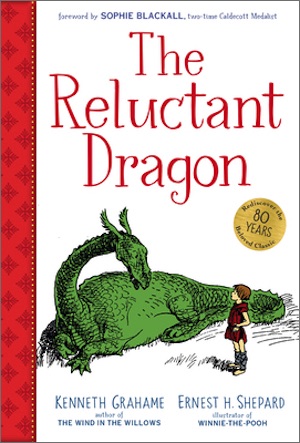
Sometimes dragons just don’t wanna dragon. They’re more the peace-loving sort, who don’t appreciate being considered an object of scorn or fear. They just want to enjoy their poetry and the lovely view and be left alone. This 1898 short children’s story is one of the very first known tales of a sympathetic dragon (though obviously not the last). Neither the dragon nor the boy who befriends him are named, though St. George (noted dragon-slayer) does show up at one point. The boy introduces George to the dragon-who-wants-to-be-left-alone and they agree to hold a fake joust to make the townspeople feel better about having a dragon in their midst. After a bit of thrust-and-parry for show, George announces that the Dragon is of no threat, and he becomes part of the community.
Chrysophylax Dives (Farmer Giles of Ham by J.R.R. Tolkien)
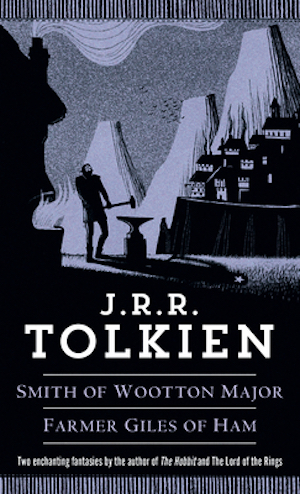
Smaug is hardly the only example of Tolkien dipping into dragon lore—Chrysophylax Dives (whose first name means “gold guard” in Greek, and whose last name means “rich” in Latin) is also fearsome and determined…but definitely does not dwell in the earnest lands of Middle-earth. Instead, these are the satiric, alt-history Dark Ages of Britain, in which a farmer who becomes an accidental hero is gifted with a dragon-thrashing sword. When a curious Chrys shows up to see what mayhem he can create, the farmer is able to take care of him and get the dragon to promise to share his hoard. Tamed by the sword and the farmer’s wit, Chrys ends up living in a barn on the farmer’s property, effectively turned into a bodyguard for the new, wealthy lord of the land.
***
Buy the Book
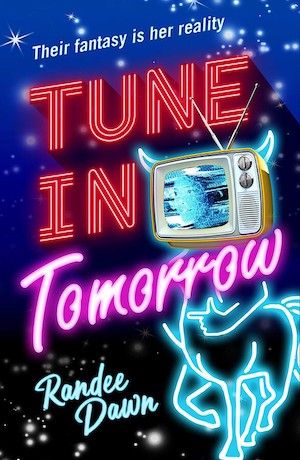

Tune in Tomorrow
Randee Dawn is a Brooklyn-based entertainment journalist who scribbles about the glam world of entertainment by day, then spends her nights crafting wild worlds of fiction. Her debut novel, Tune in Tomorrow, about a fantastical TV reality show packed with soap opera-style twists, will publish on August 23 (Solaris). Dawn has written for Variety , The Los Angeles Times, Emmy Magazine and Today.com and is the co-author of The Law & Order: Unofficial Companion. Find out more on Twitter, and RandeeDawn.com










